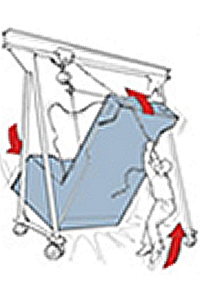Worker seriously injured when struck by falling load
Date of incident: December 2012
Notice of incident number: 2012170090216
Employer: Automotive repair shop
Incident summary
Two workers were using a small A-frame gantry crane on wheels to lift a 1,990-pound metal truck bed off a flatdeck tow truck. The bed, designed to house a welding machine and equipment, had recently been fabricated for installation onto the chassis of a truck that would provide mobile welding services. Once the truck bed was suspended above the flatdeck tow truck and the truck was then moved out from under the bed, the bed tilted forward and fell to the ground, pinning one worker underneath. The worker suffered serious crushing injuries.
Investigation conclusions
Cause
- Suspended load fell onto worker: A worker was seriously injured when a truck bed was lifted off a flatdeck tow truck and readied for placement onto a truck chassis. The front of the bed was heavier than the back, causing the wire-rope sling - which was being used to lift the truck bed - to slip. The truck bed fell to the ground, pinning the worker under its back end.
Underlying factors
- Failure to follow safe lifting procedures: The supervisor and the workers did not know the weight of the truck bed, as required by section 14.36 of the Occupational Health and Safety Regulation (the Regulation), which states in part that the weight of a load must be determined before being lifted. In addition, the Regulation states that before lifting a load with a crane, the load must be secured during the lift "to ensure that all or any part of the load cannot be dislodged."
Various types and configurations of slings and rigging techniques could have been used to lift and to properly balance the truck bed. The rigging arrangement at the time of the incident did not account for the uneven weight distribution of the truck bed, which was heavier at the front than at the back. As a result, the load tilted and then fell to the ground as it was being lifted. - Inadequate training to operate crane and to rig loads: The injured worker may have received rigging training at a previous worksite. However, the training would have occurred several years before the incident and had not been updated since. Both workers involved in lifting the truck bed had not received any training related to the use of the gantry crane. The supervisor had also not received any training on the gantry crane, and had used it only once since it was put into service.
- Inadequate supervision to ensure safety: The injured worker did not receive any direction and the other worker involved in the incident received only minimal direction from the supervisor. The supervisor was not qualified to operate the gantry crane, to train workers to use it, or to supervise workers using it.
- Gantry crane not certified: The gantry crane had been repaired as directed by a professional engineer. However, it had not been certified by a professional engineer, as required by the Regulation after the repairs were completed.
2021-04-22 20:42:33

